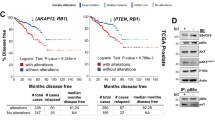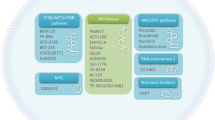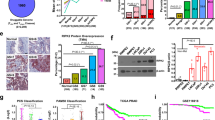Abstract
Protein kinase Pim-1 has been implicated in the development of hematopoietic and prostatic malignancies. Here, we present the evidence that two isoforms, the 44 and 33 kDa Pim-1, are expressed in all human prostate cancer cell lines examined. The subcellular localization of human 44 kDa Pim-1 is primarily on the plasma membrane, while the 33 kDa isoform is present in both the cytosol and nucleus in PCA cells. The 44 kDa Pim-1 contains the proline-rich motif at the N-terminus and directly binds to the SH3 domain of tyrosine kinase Etk. Such interaction leads to the activation of Etk kinase activity possibly by competing with the tumor suppressor p53. This is corroborated by the fact that overexpression of the 44 kDa Pim-1 in prostate cancer cells confers the resistance to chemotherapeutic drugs. Our results suggest that these two isoforms of Pim-1 kinase may regulate distinct substrates and the 44 kDa Pim-1 may play a more prominent role in drug resistance in prostate cancer cells.
This is a preview of subscription content, access via your institution
Access options
Subscribe to this journal
Receive 50 print issues and online access
$259.00 per year
only $5.18 per issue
Buy this article
- Purchase on Springer Link
- Instant access to full article PDF
Prices may be subject to local taxes which are calculated during checkout






Similar content being viewed by others
Accession codes
References
Aho TL, Sandholm J, Peltola KJ, Mankonen HP, Lilly M, Koskinen PJ . (2004). FEBS Lett 571: 43–49.
Amson R, Sigaux F, Przedborski S, Flandrin G, Givol D, Telerman A . (1989). Proc Natl Acad Sci USA 86: 8857–8861.
Breuer M, Slebos R, Verbeek S, van Lohuizen M, Wientjens E, Berns A . (1989). Nature 340: 61–63.
Chen R, Kim O, Li M, Xiong X, Guan JL, Kung HJ et al. (2001). Nat Cell Biol 3: 439–444.
Cuypers HT, Selten G, Quint W, Zijlstra M, Maandag ER, Boelens W et al. (1984). Cell 37: 141–150.
Dhanasekaran SM, Barrette TR, Ghosh D, Shah R, Varambally S, Kurachi K et al. (2001). Nature 412: 822–826.
Ellwood-Yen K, Graeber TG, Wongvipat J, Iruela-Arispe ML, Zhang J, Matusik R et al. (2003). Cancer Cell 4: 223–238.
Gregory CW, Johnson Jr RT, Mohler JL, French FS, Wilson EM . (2001). Cancer Res 61: 2892–2898.
Imasato Y, Xuan JW, Sakai H, Izawa JI, Saito Y, Chin JL et al. (2000). J Urol 164: 1819–1824.
Ishibashi Y, Maita H, Yano M, Koike N, Tamai K, Ariga H et al. (2001). FEBS Lett 506: 33–38.
Jiang T, Guo Z, Dai B, Kang M, Ann DK, Kung HJ et al. (2004). J Biol Chem 279: 50181–50189.
Kim O, Jiang T, Xie Y, Guo Z, Chen H, Qiu Y . (2004). Oncogene 23: 1838–1844.
Kim O, Yang J, Qiu Y . (2002). J Biol Chem 277: 30066–30071.
Koike N, Maita H, Taira T, Ariga H, Iguchi-Ariga SM . (2000). FEBS Lett 467: 17–21.
Leverson JD, Koskinen PJ, Orrico FC, Rainio EM, Jalkanen KJ, Dash AB et al. (1998). Mol Cell 2: 417–425.
Mochizuki T, Kitanaka C, Noguchi K, Muramatsu T, Asai A, Kuchino Y . (1999). J Biol Chem 274: 18659–18666.
Qiu Y, Robinson D, Pretlow TG, Kung HJ . (1998). Proc Natl Acad Sci USA 95: 3644–3649.
Saris CJ, Domen J, Berns A . (1991). EMBO J 10: 655–664.
Shirogane T, Fukada T, Muller JM, Shima DT, Hibi M, Hirano T . (1999). Immunity 11: 709–719.
Valdman A, Fang X, Pang ST, Ekman P, Egevad L . (2004). Prostate 60: 367–371.
van Lohuizen M, Verbeek S, Krimpenfort P, Domen J, Saris C, Radaszkiewicz T et al. (1989). Cell 56: 673–682.
von Lindern M, van Agthoven T, Hagemeijer A, Adriaansen H, Grosveld G . (1989). Oncogene 4: 75–79.
Wang S, Gao J, Lei Q, Rozengurt N, Pritchard C, Jiao J et al. (2003). Cancer Cell 4: 209–221.
Wang Z, Bhattacharya N, Mixter PF, Wei W, Sedivy J, Magnuson NS . (2002). Biochim Biophys Acta 1593: 45–55.
Yan B, Zemskova M, Holder S, Chin V, Kraft A, Koskinen PJ et al. (2003). J Biol Chem 278: 45358–45367.
Zhao T, Heyduk T, Eissenberg JC . (2001). J Biol Chem 276: 9512–9518.
Acknowledgements
We would like to thank Dr CW Gregory for providing the CWR-R1 cells for our study. This work was supported in part by the NIH Grant (CA85380) and DOD Grant (DAMD17-03-1-0117) to YQ, DOD Postdoctoral Fellowship (W81XWH-04-1-0015) to ZG, and DOD Predoctoral Fellowship (PC050649) to KX.
Author information
Authors and Affiliations
Corresponding author
Rights and permissions
About this article
Cite this article
Xie, Y., Xu, K., Dai, B. et al. The 44 kDa Pim-1 kinase directly interacts with tyrosine kinase Etk/BMX and protects human prostate cancer cells from apoptosis induced by chemotherapeutic drugs. Oncogene 25, 70–78 (2006). https://doi.org/10.1038/sj.onc.1209058
Received:
Revised:
Accepted:
Published:
Issue Date:
DOI: https://doi.org/10.1038/sj.onc.1209058
Keywords
This article is cited by
-
PIM1/STAT3 axis: a potential co-targeted therapeutic approach in triple-negative breast cancer
Medical Oncology (2022)
-
Long Noncoding RNA KCNQ1OT1 Confers Gliomas Resistance to Temozolomide and Enhances Cell Growth by Retrieving PIM1 From miR-761
Cellular and Molecular Neurobiology (2022)
-
A systematic review on active sites and functions of PIM-1 protein
Human Cell (2022)
-
Direct phosphorylation and stabilization of HIF-1α by PIM1 kinase drives angiogenesis in solid tumors
Oncogene (2021)
-
PIM kinase inhibition: co-targeted therapeutic approaches in prostate cancer
Signal Transduction and Targeted Therapy (2020)



